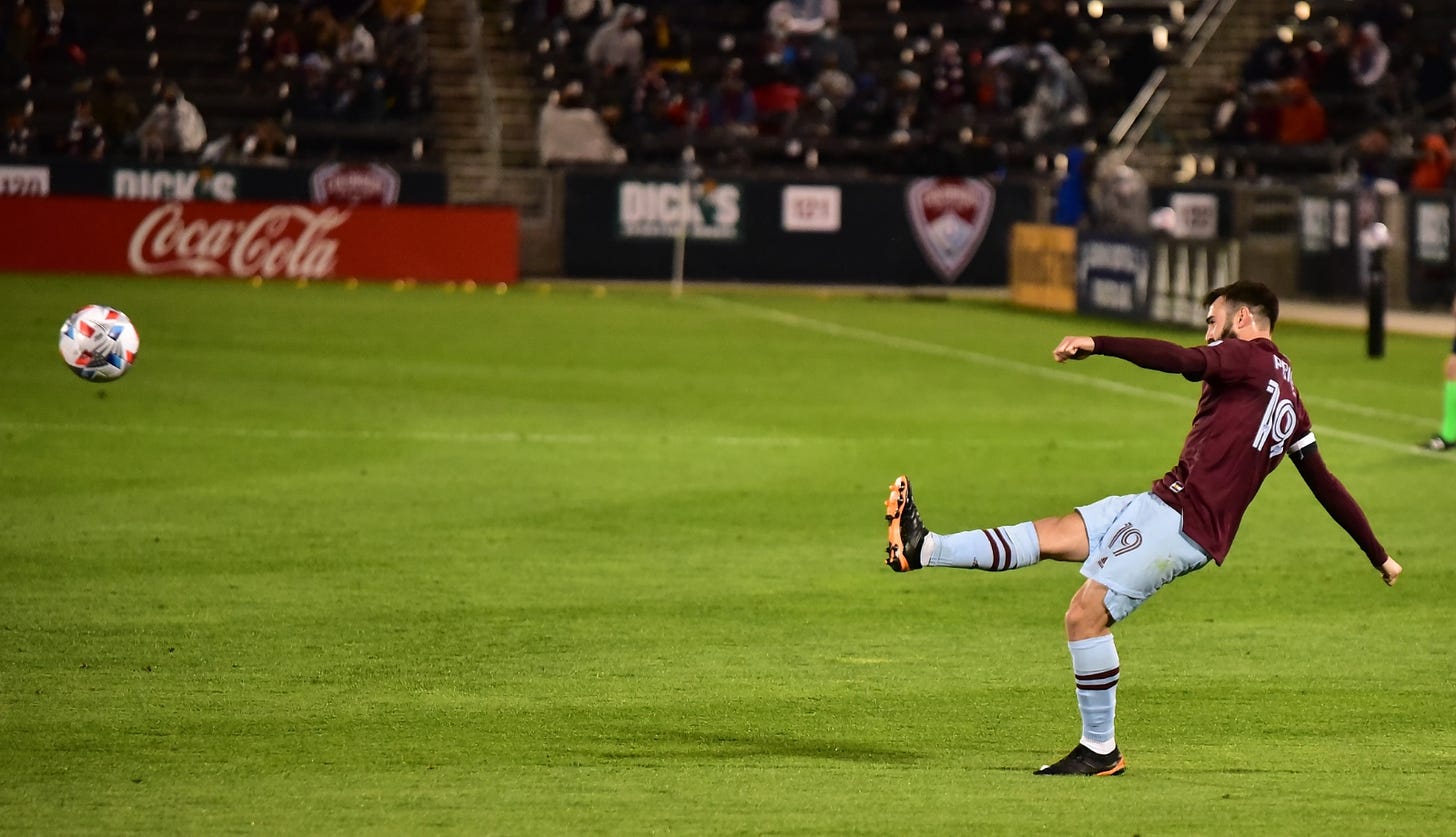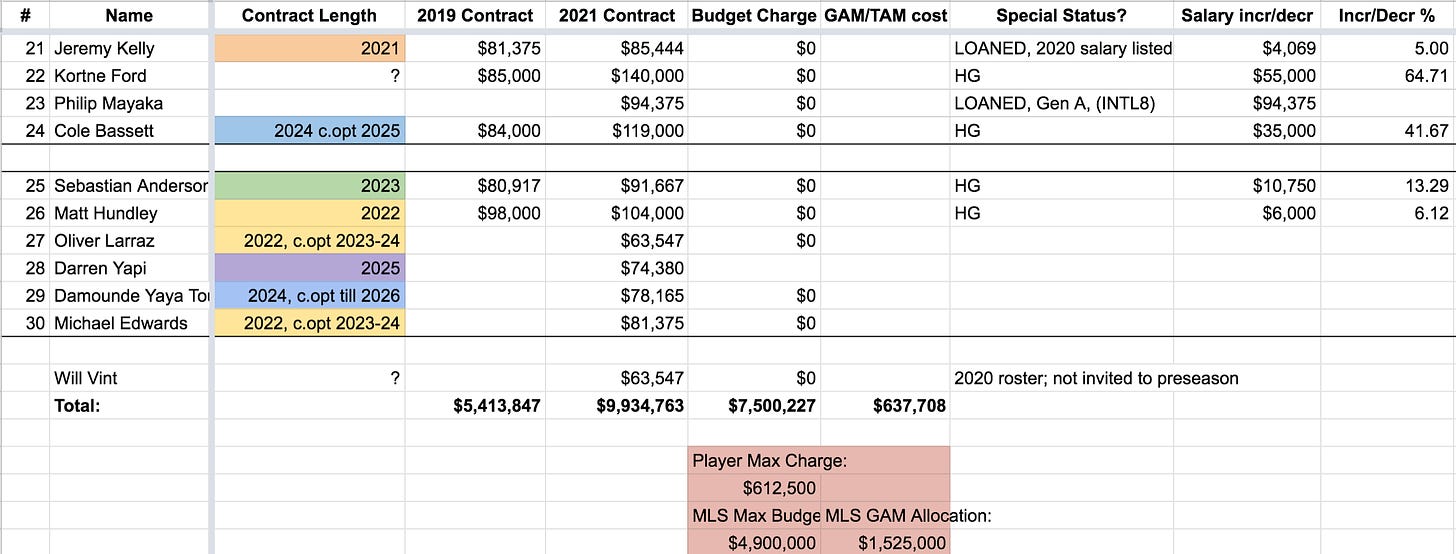Backpass: Dollah Dollah Bills, Y'all
What we learned from the MLSPA salary news dump about the Rapids.

Because of the pandemic (how many times have your heard that phrase over the last 15 months?) the Major League Soccer Players Association (MLSPA) didn’t release salary data at all in 2020. Which meant that the release of that info this week was extra, extra sweet.


Maybe it’s overstating to compare salary dump day to Christmas. I mean, I’m Jewish, how would I know?
It’s an exciting infusion of much needed for nerds like me (and if you’re reading this with glee and excitement, nerds like *us*) because it helps us to get clarity on the direction of an organization, or the mistakes that have been made to date. There are some fairly mundane observations; yes, Carlos Vela and Javier ‘Chicharito’ Hernandez are the highest paid players in the league. And there are some revelations; FC Cincinnati spent a lot of money - fifth highest payroll in MLS - to finish dead last and earn the Wooden Spoon. They also led MLS in million-dollar players, with six. Yikes.
On team-by-team basis, the salary dump allows us as supporters to understand the direction of the club, and additionally, how much wiggle room there is midseason to make some additions in the event that our team wants to make a deep run.
I’ve been keeping close track of the intricate details of the Rapids roster for four years now - a much easier task now than it used to be, since the league has increased its transparency with things like roster rules, GAM and TAM1 spending, and contract length. So behold, I share with you this day: my current, updated Rapids roster spreadsheet.2
Part the First: What we learned from the top of the roster
Here’s the deets on the first 12 roster spots, and my observations.
Some basic things: Kellyn Acosta, Younes Namli, and for the first time in his career, Jack Price, carry a salary in excess of the maximum player budget charge of $612,500. That simply means that the team needs to designate some of the special Garber bucks (or a DP slot) to those players in order to be roster compliant.
The Rapids have just two million-dollar babies, Namli and Acosta - in a league where 67 players earn $1 million or more, and both of the Rapids players make only a smidgeon over a million. By comparison, Inter Miami dropped a total of $9.1 million on just Gonzalo Higuain and Rodolfo Pizarro - that’s almost the cost of the *entire* Colorado roster. And with that, Miami finished 7-13-3 (WLT) last year. So the Rapids spending looks intelligent and well controlled, even if one could argue that neither Acosta (2g, 1a) nor Namli (2g, 3a) is tearing it up in terms of numbers.3
Price, meanwhile, is the classic backloaded-contract-for-a-veteran. This structure allows a team in the first years of a player contract to acquire that guy without busting up the rest of the roster. And the player typically loves it because they know that they’ll be handsomely paid down the road, even in the years beyond when they have physically peaked, which in soccer is typically at age 26 to 28.
It’ll take till we look at all three parts of the contract chunks, but I’ll start mentioning it now: remember back when the Rapids were saddled with big, expensive contracts for unproductive players back in 2016, 2017, and 2018: Tim Howard and Shkëlzen Gashi as the DPs, plus Joe Mason, Nana Boateng, Stefan Aigner, and Yannick Boli? And we were just waiting till those contracts expired to be able to do anything? There’s none of that anymore. This roster is right-sized and affordable, and as you can see, we have a bunch of players whose contracts expire this season. Flexibility galore.
Nothing else here is particularly surprising. Keegan Rosenberry and Lalas Abubakar got well-deserved pay raises. I do not think Keegan will be parking cars on the weekend for extra cash with that kind of salary.
…
Part the Second: This next chunk of the Rapids roster is fascinating
The eye-popping revelation I think in this roster is that Sam Vines is getting paid. And rightly so - the kid from Colorado Springs went from ‘hey that’s nice the local boy made good’ to a regular topic of conversation amongst the USMNT and ESPN talking heads in a blink. Colorado absolutely did the right thing in giving him a 500% salary increase in order to lock him down till 2024, and I still think a 2022 (or earlier) sale to Europe is a good possibility. The long contract means that Colorado can sell him for a transfer fee - and they will almost certainly need to sell him, because in 2024, if he continues to impress - perhaps becoming the regular starting LB for the USMNT, Colorado will almost certainly not be able to afford him.
Danny Wilson’s first contract bugged *everybody* in Rapids talking-head land. I wrote that he was “a poor use of club resources” back in 2018 - he was eating up a lot of budget space to be a really bad defender back then. So the Front Office signing him to a new two-year deal at a 46% pay cut is really good, and so far he’s playing fairly well, with generally good defense - and he recently had that game-winning goal. So I don’t hate this.
The FO spent some of that savings on Austin Trusty, who is talented and also a work in progress.
The entire defense costs roughly what they ought to cost. I’ve been writing about the Rapids since 2013, and I can’t remember ever looking at the roster and concluding that, more or less, everybody here is making what they deserve. Remember that in 2014 the Rapids once paid $139,583 to an out-of-shape, lumbering defenseman named Zat Knight, and in exchange they got less than half a season of some of the worst defense ever played in American soccer.
Finally, Andre Shinyashiki is in a big year. He’s making a pittance while starting every game, and his contract expires at season’s end. If he gets 10 goals this year, he can ask for a massive raise. If he can’t produce by midseason, he’ll get moved to the bench and likely end up in the re-entry draft or the USL as the team moves on to another prospect like Darren Yapi or Matt Hundley.
Part the Third: The freebies; and the total cost
Roster spots 1 through 20 in MLS count towards your overall maximum salary cap of $4.9 million. Spots 21 through 30 do not count4, but they have to be minimum salary players, homegrowns, or recent college grads. And if a homegrown becomes too expensive, like Sam Vines, they must be moved to the ‘Senior’ roster of spots 1-20. Vines, however, got $206,075 dollars knocked off his total budget charge as a homegrown discount.5
The lowest-paid player on the Rapids roster is Oliver Larraz, making the rookie minimum. Larraz is 19 years old. When I was 19 years old, I had a summer job as a camp counselor. I worked for eight weeks. I was paid $1000. When I was 21, I got a job selling shoes at a sporting goods store, which sucked, except for the time that Ziggy Marley and the Melody Makers came in and cleaned us out. I think I earned $3000 at that job. When I was 23 years old, I was a social worker in New York City. I earned $13,000 that year. When Larraz has his big breakout year, he’ll quickly be handed a six-figure deal. So, do not cry for Oliver Larraz.6
Cole Bassett is interesting here as a contrast to Sam Vines. It might be a little awkward to know that there’s a pretty large disparity between what Sam makes and what Cole makes, considering that might be a minor divide between the two buddies, or that it might be perceived as an implication of how the team values one much higher than the other.
That’s not really the case. This is likely due to the fact that Bassett is on his first contract, as he was signed in 2018 to a six-year deal, while Vines is on his second deal, signed earlier this year - Sam and Cole both made rookie-type money until Sam’s deal was nearing its end. His second deal is better; and thus we can assume that if the club is still high on Bassett, his second deal will be better, too. There’s no pressure on Bassett to produce right now; he’s got time to develop. And he is also the only player on the supplemental or reserve roster contributing regularly for the Rapids, and so from the team’s perspective, his contract situation is totally chill.
The literal bottom line on the chart above - the bolded numbers to the right of the word ‘totals’ - is also the metaphorical bottom line for this club right now.
The Rapids overall roster budget charge is $7.5 million, or $2.6 million over the maximum budget charge. They have $1.5m in GAM and $2.8m in TAM to buy down players below the charge. $637K has to go to 5 players (Michael Barrios, Nicolas Benezet, Diego Rubio, Acosta, and Price) who are over the $612K salary max. The rest they can spread around as they wish to get under the cap, and unless they’ve spent some of that on trades (which I haven't closely tracked) or transfer fees (which are undisclosed), they still have cash to splash midseason if they want to spend a little. According to the above math, they likely have $500,000 to 1.1 million to spend, give or take a few hundred grand either way.
They also have *two* open DP slots, although we all know that KSE’s frugality means a big DP signing feels unlikely. It would not surprise me, though, if the Rapids decided to add one or two mid-salary TAM-level levels at the $300-600K level midseason, perhaps moving Kellyn Acosta to a DP slot in order to free up any needed cash. If Pádraig Smith thinks the team can loot a good cog from a floundering domestic team going towards the playoffs, it would make good sense to do it, and it wouldn’t be a financial imposition at all on this club.
The basic back of the envelope math strongly indicated that the Rapids had financial freedom at the start of the season, but the MLSPA salary data dump made that more concrete and official. Colorado’s lack of high-priced players and robust use of the SuperDraft and academy has given them a solid team and tremendous flexibility. All of that makes for a bright future for which we should all be fairly thankful.
GAM is General Allocation Money. Every team gets $1.5 million for 2021. TAM is Targeted Allocation Money, of which MLS teams get a base of $2.8 million, plus more if they don’t qualify for the playoffs, qualify for CCL, or lose a player in an expansion draft. These amounts of money effectively raise every teams salary cap and especially help to incentivize teams to spend at the ‘high-middle’ spots of the roster, your #4-8 highest-paid players, who aren’t DPs but also aren’t rookies or replacement-level scrubs.
It is entirely possible that there are a few errors here. True story: I once wrote a piece like this for Burgundy Wave a few years ago, and then got a call with a senior official in the Rapids front office who told me ‘you got a bunch of stuff wrong.’ I said ‘Great! What stuff did I get wrong?’ They said ‘We can’t tell you.’ (Mostly what I got wrong was approximating the club’s salary cap space and GAM and TAM totals. Those numbers here are still not likely *dead on* for a whole boatload of reasons). But back then, contract lengths, GAM and TAM amounts, and even some of the roster mechanisms were undisclosed. Most of that, I think, is no longer true. As you can see though, there are still a few players on the roster for whom we do not know their contract length.
You didn’t really think I’d just quote some lame old counting statistics without a slightly more intelligent look, right? Acosta had a +2.75 g+ in 2020, good for fourth on the team. Namli had second-on-the-team +3.40 g+, with a 1.21 dribbling g+ which was good for fourth-highest in all of MLS. To me, the threat they create and their overall contribution is well-worth a million dollar salary. And also - I’d like them to get more goals and assists.
They are called the ‘supplemental roster’ (21-24) and the ‘reserve roster’ (25-30).
It’s called the Homegrown Player Subsidy. Yes the rules are confusing, but this one is really good for teams that prioritize the academy, like Colorado, and so it’s a good thing.
The senior minimum salary, however, is $81,375. Collen Warner, Jared Stroud, Marlon Hairston, Boniek Garcia, and Chase Gaspar are all earning that. Which is a damn shame in my opinion. Warner, Hairston, and Garcia have absolutely paid their dues and should be making a lot more. Gaspar and Stroud are regularly starters and are both very good. The senior minimum (and really, the rookie minimum) needs to be above $100K.









